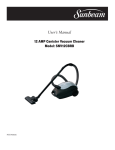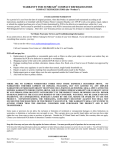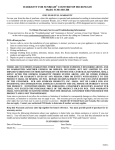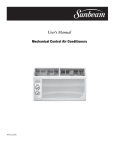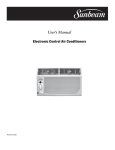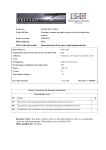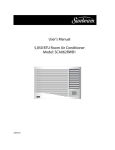Download User`s Manual 2.8 Cu. Ft. Refrigerator Model: SCR03PMWBW
Transcript
User’s Manual 2.8 Cu. Ft. Refrigerator Model: SCR03PMWBW PTT061506 Table of Contents Name of Parts Cautions Positioning Your Refrigerator Ventilation Power Supply Power Cord Moisture Protection Heat Protection Stable Positioning Keep Away From Danger Moving the Refrigerator Using Your Refrigerator Temperature Control Reversing the Door Maintenance Before You Call for Service 3 4 4 4 4 4 5 5 5 5 5 5 5 6 7 7 2 Name of Parts 1. 2. 3. 4. 5. 6. 7. 8. 9. Freezer Door Ice Cube Tray Temperature Control Knob Drip Tray Removable Shelf Glass Board Bottle Rack Dairy Racks Tin Rack Note: This figure is only a sketch of the refrigerator; the actual product may differ. WARNINGS: • Keep ventilation openings, in the appliance enclosure or built-in structure, clear of obstruction. • Do not use mechanical devices or other means to accelerate the defrosting process. • Do not use electrical appliances inside the food storage compartments of the appliance. 3 Cautions • • • • • • • Water getting into air inside the refrigerator by opening doors may form a layer of frost inside, which may weaken the refrigerator. Defrost your refrigerator when frost reaches .68 inches (2mm). You must manually defrost your refrigerator. Before defrosting, set the temperature control knob and set it to “0” (where the compressor will stop). Leave the door open until the ice and frost dissolve. To speed up defrosting, place a bowl of warm water approx. 120ºF (50ºC) into the evaporator. Do not heat the evaporator directly with hot water or a hair dryer while defrosting to prevent deforming the inner case. Do not scrape off ice and frost with sharp tools or wooden bars, as not to damage the inner casing or the evaporator surface. If the power cord is damaged, it must the replaced by the manufacturer, its service agent, or a similarly qualified person in order to avoid hazard. Before you throw away your refrigerator, take off the door but leave the shelves in place so children may not easily climb inside. Never allow children to operate, play with, or crawl inside the refrigerator. Positioning Your Refrigerator Ventilation • The refrigerator needs to be well-ventilated to easily dissipate heat and cause high refrigerator efficiency and low power consumption. • Sufficient ventilation space requires the back of the refrigerator to be at least 4 inches away from the wall, each side of the refrigerator to be at least 8 inches away from the wall, and the top to clear at least 12 inches. A clear space should be left 160º for the door to open. Power Supply • This refrigerator operates with a single phase alternating current power source. • If you live in an area where there is a large range of supply voltage (brown outs, etc.), you may need a voltage regulator. • The plug must match the socket with a grounded wire. Power Cord • Do not lengthen or fold the cord into a coil during operation. • Due to high temperatures, do not keep the power cord close to the refrigerator compressor. This could cause deactivation to the insulation or electrical leakage. • Do not use an extension cord. • Position the refrigerator so the plug is accessible. WARNING: • If the power cord is damaged, it must the replaced by the manufacturer, its service agent, or a similarly qualified person in order to avoid hazard. For support, visit www.sunbeammajorappliances.com or in the US call 1-866-866-6283. 4 Moisture Protection • To minimize the possibility of rust, avoid placing the refrigerator in a place with heavy moisture. • Do not directly spray with water; this will cause poor insulation and current leakage may occur. Heat Protection • The refrigerator should be kept out of direct sunshine and away from any heat sources. Stable Positioning • Place refrigerator on a flat and solid surface. • Do not place refrigerator on soft material such as foam, plastic, etc. • If the refrigerator is not on a flat surface, adjust the screws appropriately. • The refrigerator should not be placed in an area with an echo. Keep Away From Danger • Do not place the refrigerator near any combustibles such as gas, petrol, alcohol, lacquer, etc. • Do not store the above mentioned products in the refrigerator. Moving the Refrigerator • When fixed or moved, the refrigerator cannot be set horizontally or declined to more than 45º or upside-down. Using Your Refrigerator Temperature Control • The temperature control settings are “0-8”. • The first time you turn on the refrigerator, set the temperature control to “8”. After 20 minutes, adjust the temperature control setting to “4”. The correct setting for home or office use is “4”. • To turn the refrigerator off, set the temperature control to “4”. Notes: • Turning the temperature control to “0” stops the cooling cycle but does not shut off the power of the refrigerator. • If the unit is unplugged or the power is lost or turned off, you must wait 3 to 5 minutes before restarting the unit. If you attempt to reset before waiting, the refrigerator will not start. • To conserve energy, put your refrigerator in the coolest place in your room. If the environment temperature is too high, the temperature in the refrigerator may not get the target temperature. 5 Reversing the Door This refrigerator has the capability to either open from the right or left side. The default door will open from the left side. Should you wish to reverse the opening direction, follow the directions below. Note: All removed parts must be saved to reinstall the door. To Reverse Refrigerator Door 1. Remove the hinge cap (9). 2. Using a sharp object, carefully pry out the plug buttons (1). 3. Remove the two screws (8) connecting the upper hinge (7) on the right side of the cabinet top. 4. Carefully lift the door and place it on a padded surface to prevent scratching. 5. Remove the plug (2) and transfer it to the uncovered hole at the right side. Be sure to press the button firmly into the hole. 6. Remove the two bolts (5) holding the lower hinge (6) on the right side. 7. Remove the screw leveling front leg (3) and transfer it to the right side, as shown in the figure below. 8. Set the door into its new place, making sure the pin enters the bushing at the lower frame section (hole). 9. Secure the upper hinge (7) previously removed on the left side, making sure the pin enters the bushing at the lower frame section (hole). 10. Loosely secure the lower left hinge (6), but do not tighten the bolts until the door is leveled and in the closed position. 11. Insert the plug buttons (9) on the uncovered holes (right side). 12. Replace the upper hinge cap (9). 1. 2. 3. 4. 5. 6. 7. 8. 9. Plug Hinge Plug (Door Frame) Leveling Front Leg Short Leg Door Hinge Bolts Lower Door Hinge Upper Door Hinge Door Hinge Screws Door Hinge Cap 6 Maintenance • • • • • • The refrigerator should be cleaned and maintained once a month. When performing maintenance, make sure the power plug is first disconnected from the power outlet. Wipe the inner and outer surface of the refrigerator and its accessories with wet cloth. If the surfaces are too dirty, scrub them with neutral detergents and then clean with water and dry with a clean cloth. A small amount of window wax is recommended to polish the refrigerator surface with a soft cotton fabric. For cleaning, do not use hot water, petrol, alcohol, kerosene, washing powder, cleanser, alkaline detergent, acid, chemical cloth, etc., so as not to damage the lacquer coat and plastic. Do not spray directly with water; this may cause rust or weaken the insulation. Be sure to keep the sealing rubber bars of the door clean or they will age and crack. Be sure to clean the drain tray frequently to avoid refrigerator odors. Before You Call for Service Before you call for service, review this list. It may save you time and expense. The list includes common occurrences that are not the result of defective workmanship or materials in this appliance. 1. When the refrigerator does not work: a. Check if there is power failure. b. Check if the power cord is plugged into the power outlet. c. Check that the fuse has not blown. 2. When the refrigerator is cooling excessively: a. The temperature control dial may be set too high. b. If you place foods containing high amounts of moisture directly under the air outlets, they will freeze easily. This does not indicate malfunction. 3. When the refrigerator is not cooling sufficiently: a. The food may be packed too tightly into together which will block the flow of cool air. b. You may have put something hot into the refrigerator. c. The door may not have been properly closed. d. The door gaskets may be damaged. e. The refrigerator may not be ventilated. f. There may be insufficient clearance between the refrigerator and the surfaces. g. The temperature control dial may not be properly set. 4. When defrosting water overflows inside the refrigerator and onto the floor: a. Check that the drain hose is not clogged. b. Check that the drip tray is housed properly. 7 5. When the refrigerator cabinet heats up: a. In order to safeguard against condensation, there is a decondensation pipe that heats up the cabinet front when running. A warm cabinet front does not indicate malfunction. 6. When condensation forms on the outside of the refrigerator: a. Condensation may form on the outside when the humidity is high. This is the same result as the condensation formed when chilled water is poured into a glass. It does not indicate a malfunction. Wipe dry with a clean cloth. 7. When you hear a sound like flowing water: a. A sound like flowing water is the refrigerant flowing. This does not indicate a malfunction. 8. When the side panel of the cabinet heats up: a. The side panel of the cabinet will heat up when the door is opened and closed frequently, when starting the unit, and when the unit is operated in high outside temperatures. In such cases, do not touch the panel. This results from dissipation of the heat from inside the cabinet. This does not indicate a malfunction. 8 © 2006 Sunbeam Products, Inc. doing business as Jarden Consumer Solutions. All rights reserved. Sunbeam is a registered trademark of Sunbeam Products, Inc. used under license. Distributed by Petters Consumer Brands, LLC. 4400 Baker Road, Minnetonka, MN 55343. ® For service, support and warranty information, visit www.sunbeammajorappliances.com or in the US call 1-866-866-6283. 9









